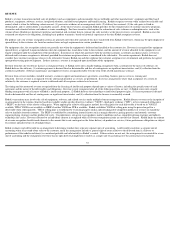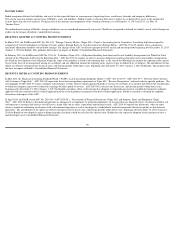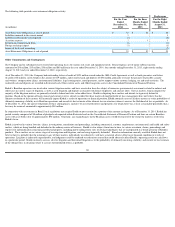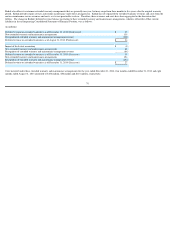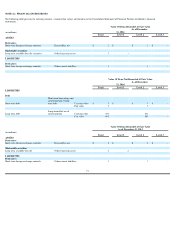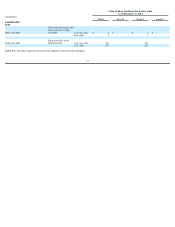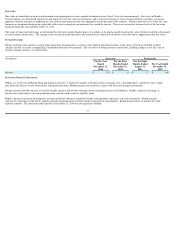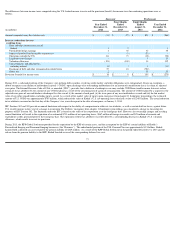Kodak 2014 Annual Report Download - page 70
Download and view the complete annual report
Please find page 70 of the 2014 Kodak annual report below. You can navigate through the pages in the report by either clicking on the pages listed below, or by using the keyword search tool below to find specific information within the annual report.
On June 17, 2013, the Company, the New York State Department of Environmental Conservation and the New York State Urban Development Corporation, d/b/a Empire
State Development entered into a settlement agreement, subsequently amended on August 6, 2013 (the “Amended EBP Settlement Agreement”). The Amended EBP
Settlement Agreement was subject to the satisfaction or waiver of certain conditions including a covenant not to sue from the U.S. Environmental Protection Agency
(“EPA”). On May 13, 2014, the Bankruptcy Court approved the U.S. Environmental Settlement, which contained the EPA covenant not to sue, and on May 20, 2014 the
Amended EBP Settlement Agreement was implemented and became effective. The Amended EBP Settlement Agreement included a settlement of certain of the Company’s
historical environmental liabilities at Eastman Business Park (“EBP”)
through the establishment of the EBP Trust as follows: (i) the EBP Trust is responsible for investigation
and remediation at EBP arising from the Company’s historical subsurface environmental liabilities in existence prior to the effective date of the Amended EBP Settlement
Agreement, (ii) the Company funded the EBP Trust on the effective date with a $49 million cash payment and transferred certain equipment and fixtures used for remediation
at EBP and (iii) in the event the historical liabilities exceed $99 million, the Company will become liable for 50% of the portion above $99 million. Prior to the
implementation of the Amended EBP Settlement Agreement, $49 million was already held in a separate trust and escrow account.
Prior to the bankruptcy filing, Kodak was designated as a potentially responsible party (“PRP”) under the Comprehensive Environmental Response, Compensation and
Liability Act of 1980, as amended (the “Superfund Law”), or under similar state laws, for environmental assessment and cleanup costs as the result of Kodak’s alleged
arrangements for disposal of hazardous substances at eight Superfund sites. In connection with the Bankruptcy Filing, the Debtors provided withdrawal notifications or entered
into settlement negotiations with involved regulatory agencies. Each of these sites has been resolved.
In addition, the Company provided an indemnity as part of the 1994 sale of Sterling Corporation (now “STWB”),
which covered a number of environmental sites including the
Lower Passaic River Study Area (“LPRSA”) portion of the Diamond Alkali Superfund Site. STWB, now owned by Bayer Corporation, is a potentially responsible party at the
LPRSA site based on alleged releases from facilities formerly owned by subsidiaries of Sterling. On February 29, 2012, the Company notified STWB and Bayer that, under
the bankruptcy proceeding, it elected to discontinue funding and participation in remedial investigations of the LPRSA. STWB and its parent, Bayer, filed proofs of claim
against the Debtors in the Chapter 11 Cases. These claims have been discharged pursuant to the Plan. Four sites that are owned by the Company were not resolved by the
discharge.
On January 14, 2015, the Company sold its property in Middleway, West Virginia and transferred the related environmental liability to Commercial Liability Partners WV,
LLC (CLP). As part of the transaction, the Company withdrew from its Voluntary Remediation Agreement with the West Virginia Department of Environmental Protection,
received an indemnity from CLP regarding any environmental obligations, and was named insured in an environmental insurance policy for a period of ten years in the case of
breach by CLP. As of December 31, 2014, the $2 million net book value of the Middleway property was classified in Current assets held for sale and the environmental
liability of approximately $9 million was classified as Current liabilities held for sale. The Company released the environmental liability associated with the site and
recognized a gain of approximately $3 million on the transaction in 2015.
Estimates of the amount and timing of future costs of environmental remediation requirements are by their nature imprecise because of the continuing evolution of
environmental laws and regulatory requirements, the availability and application of technology, the identification of presently unknown remediation sites and the allocation of
costs among the potentially responsible parties. Based on information presently available, Kodak does not believe it is reasonably possible that losses for known exposures
could exceed current accruals by material amounts, although costs could be material to a particular quarter or year.
Asset Retirement Obligations
Kodak’s asset retirement obligations primarily relate to asbestos contained in buildings that Kodak owns. In many of the countries in which Kodak operates,
environmental regulations exist that require Kodak to handle and dispose of asbestos in a special manner if a building undergoes major renovations or is
demolished. Otherwise, Kodak is not required to remove the asbestos from its buildings. Kodak records a liability equal to the estimated fair value of its obligation to
perform asset retirement activities related to the asbestos, computed using an expected present value technique, when sufficient information exists to calculate the fair
value. Kodak does not have a liability recorded related to every building that contains asbestos because Kodak cannot estimate the fair value of its obligation for certain
buildings due to a lack of sufficient information about the range of time over which the obligation may be settled through demolition, renovation or sale of the building.
67


